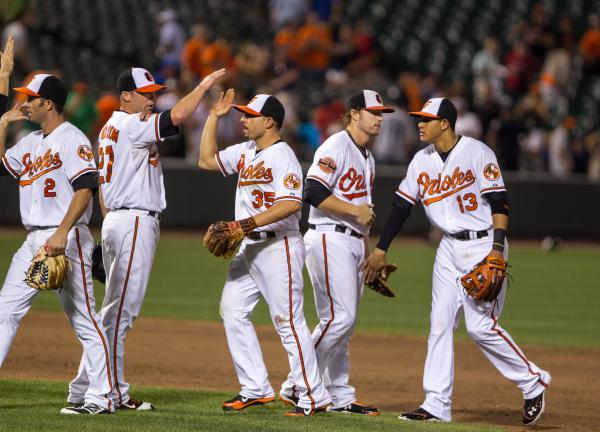It's almost always a fool's errand to describe why a progressive movement, or a particular way of thinking, has no chance of succeeding.
Since the future's mostly unknown and developments we cannot anticipate often occur, it's safer and wiser to acknowledge that success, while perhaps a long shot in the making, is a possibility. Simply ruling it out is risky business.
However, that said, when it comes to ongoing scientific attempts in the research community to quantify "team chemistry" in baseball – and break it down into its parts, and create accompanying metrics so it can be measured and potentially replicated – I'm going to don that fool's (ball) cap and just say it.
This cannot be done.
I know how that sounds. Closed-minded. Old school, if not ancient. But my thinking is that while scientific study is the key to unlocking so much of what is unknown, there are other things that are simply intuitive, and natural, and occur from human happenstance. And that this essential intangible for baseball success, where players on a winning team form a cohesive, supportive interactive bond that helps power the ballclub to victory, cannot be deconstructed into units and measured so that a winning chemistry can be reproduced.
That's not to say that teams can't take steps to create good team chemistry, like assembling a roster of players of compatible personalities and undertaking team-bonding activities to inspire unity. This concept has been in place for a while now, as the Chicago Cubs, led by their chief chemist Joe Maddon, has notably demonstrated for the baseball world. This unconventional, ingenious manager keeps his players loose and makes them laugh.
 The current 64-year-old skipper with spiky white hair likes to stage "pregame petting zoos" and "pajama road trips." Oh, and after that 2016 season when these Maddon moments occurred, he led the Cubs to the franchise's first World Series title in 108 years. The zaniness wasn't the reason Chicago won it all; of course, the Cubs had talented ballplayers. But Maddon (pictured), the mild-mannered mad-professor, knew how much of it to sprinkle into the clubhouse cauldron to get his team's chemistry just right.
The current 64-year-old skipper with spiky white hair likes to stage "pregame petting zoos" and "pajama road trips." Oh, and after that 2016 season when these Maddon moments occurred, he led the Cubs to the franchise's first World Series title in 108 years. The zaniness wasn't the reason Chicago won it all; of course, the Cubs had talented ballplayers. But Maddon (pictured), the mild-mannered mad-professor, knew how much of it to sprinkle into the clubhouse cauldron to get his team's chemistry just right.
Today, there are at least three studies underway on both the minor- and major-league levels seeking to identify and measure healthy team chemistry. One study, involving the San Francisco Giants' minor-league team in San Jose and recently featured in The Atlantic, "installed cameras with the goal of monitoring associations between dugout interactions — high fives, back pats — and team success."
"The central goal is to understand the processes that underlie the formation and maintenance of personal reputation and team chemistry/team cohesion through a series of studies that implement a multi-method approach," states a Spring 2017 job posting at University of California, Berkeley, seeking research assistants for the project. "Study designs include qualitative data collection, gathering video and narrative accounts (and subsequent qualitative data coding), watching interviews and games and coding based on set coding procedures, etc."
Now it's worth noting that teams have won without sporting good team chemistry – who can forget the feuding, brawling 1977 World Champion New York Yankees of Reggie Jackson, Thurman Munson and Billy Martin? – but that team was emblematic of the exception rather than the rule.
Here's the obvious question that stands out: How can counting fist bumps and smiles, and tracking celebrations and disagreements, shed light on how to measure chemistry? The short answer is: It can't. There's no precise number of hugs, or range of positive interactions, that makes someone a better teammate. Obtaining players who possess the traits and insights that make them a positive influence, yes, that can be done. And jettisoning "clubhouse cancers" who are critical of teammates and overly selfish (provided they aren't superstar talents), is also important. But team executives already know this. The formula for great chemistry isn't found in figures, it's based on human interaction.
If you believe the counter-argument to this position is the "Moneyball" model developed a couple of decades ago by the low-rent Oakland A's – when long-standing, conventional baseball thinking of talent scouts was thrown out the window – that's essentially a false equivalence. That's because Moneyball used available, overlooked statistics to identify undervalued players and their specific baseball skills that a team needed in order to win. And as for today's widely-used analytics – which, in part, produces drastic defensive shifts in the field against certain batters that habitually hit the ball in the same area – that strategy is also derived from previously-collected stats.
Moreover, teams don't win in a vacuum. Some degree of luck is always involved, which means that all the great team chemistry in the world cannot supersede events that take place between the foul lines. One poorly-timed blunder by an opponent can send a "cohesive" team – otherwise facing defeat – to playoff victory. And vice versa.
Some things scientists do superbly. Yet I'm betting that this isn't one of them. And when it comes to this endeavor, these researchers, while well-intentioned, will find that they'll be creating additional statistical categories in a sport that already has too many of them to begin with.




